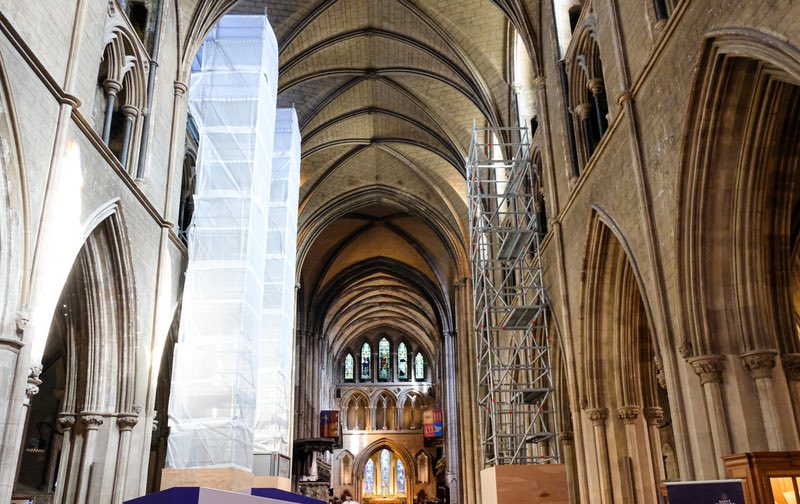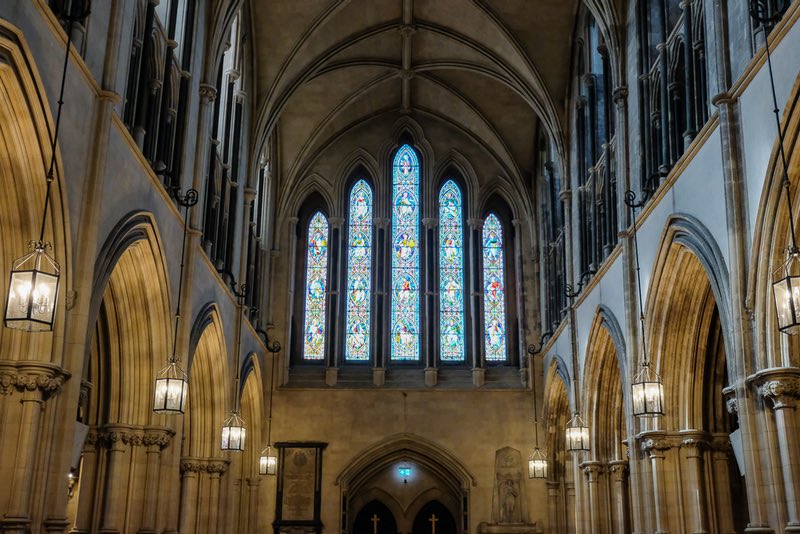Christ Church Cathedral & St. Patrick’s Cathedral in Dublin, Ireland – How Barley Barons Saved Them
By: Gail Clifford | Published By: Amateur Traveler | Sept. 19, 2020
https://amateurtraveler.com/christ-church-st-patricks-cathedral-in-dublin/
Hard to believe now, visiting two of Dublin’s most popular tourist attractions, neither of her famous Cathedrals nearly made it. Had it not been for two of the city’s great barley barons, Benjamin Guinness of the famous brewery clan, and Henry Roe of the Thomas Street distillery, we might be visiting ruins today. Their 19th-century contributions saved each church for their parishioners and our current enjoyment.

While Christ Church had formal precedence, as the mother and senior cathedral of the diocese, over St. Patrick’s Cathedral, various monarchs through time took drastic actions against one cathedral in favor of the other. Christ Church is the elder of the two medieval cathedrals and it is originally situated within the walled medieval city. This made her susceptible to the laws and taxes of the city, from which St. Patrick’s was exempt.
Christ Church Cathedral
Dublin’s Christ Church Cathedral is the oldest structure in the city at nearly 1000 years. Its architecture is a mixture of medieval, gothic and Victorian. Through multiple renovations, stained-glass windows dominate. Attention to detail is noted in specific floor tiles of the cathedral nave. Look for the foxy friars. There’s space to explore above, as you climb the staircase to the belfry to ring the famous bells, and below, as you descend to the largest medieval crypt in Ireland. The crypt contains additional treasures of Christ Church, including priceless silver and, historically priceless, Ireland’s first copy of the Magna Carta.

At the west end of the cathedral is a fully integrated stone bridge, a Dublin landmark, leading to the former synod hall. It had been built on the site of St Michael’s and was demolished by architect Street during his restoration of the cathedral. This hall, which incorporates the old St Michael’s tower, is now home to the “Dublinia” exhibition about medieval Dublin.
The Very Reverend Dermot Dunne, Dean of Christ Church Cathedral believes firmly “the mission of any cathedral is to reflect through its beauty the transcendence of God … we welcome everyone as a pilgrim and it is our hope that as the pilgrim leaves, he or she will have been touched in some way by the love of God which shines in the beauty of this place.”
Christ Church Cathedral, formally the Cathedral of the Holy Trinity, only became part of the Church of Ireland following the English Reformation. The Roman Catholic Archbishop of Dublin has used St. Mary’s on Marlborough Street as the “acting Cathedral” or ProCathedral for the past 200 years.
Christ Church History
According to Tommy Graham, Editor of Ireland’s HISTORY magazine and the fastest walking and fastest talking guide you’ll find in Dublin, Ireland was labeled “Hibernia” by the Romans, meaning “land of winter.” Ireland was never conquered by the Romans, who, “having visited once, took one look at the weather, and assuming it was always this bad, left forever.”
A church is thought to have stood at this Christ Church site since 800AD. Christ Church Cathedral, a wooden building at that stage, was founded in 1030, by Hiberno-Norse (old Irish for mixed Gaelic and Norse ancestry) King Sitric Silkenbeard after a pilgrimage to Rome. He was the Viking King of Dublin. By this time, the Vikings had become Christian.
Purported to have four old Celtic Christian churches at this time in Dublin, only Christ Church and St. Martin of Tours lay within the walls of the Viking city. Christ Church, with its original architectural context, existed at the center of a medieval street pattern, a maze of small buildings and streets.
Anglo-Normans
John Cumin, the first Anglo-Norman archbishop, is thought responsible for directing the replacement of the existing Hiberno-Norse cathedral with the Romanesque and later Gothic cathedral. Parts survive today.
The cathedral was rebuilt in stone in the 1170s by an Anglo-Norman feudal knight called Richard de Clare, the Earl of Pembroke from southern Wales. He’s better known by his nickname, “Strongbow.”
Strongbow proved himself a statesman who had “thrown in his lot” with the Irish. He learned the language and took an Irish wife. His success depended on theirs, he helped Ireland benefit from Norman rule after diplomatically convincing most of the chieftains of Leinster. He died from sepsis from a foot infection.
In the 1180s, the second Earl of Strongbow, Dermott McMurrough and other Norman magnates helped to fund the rebuilding of Christ Church. This included the construction of a choir, choir aisles, and transepts, the crypt and chapels to St. Edmund and St. Mary and St. Lô. McMurrough deposed the King of Lancaster and, in a sign of peace, promised the hand of his daughter, Aoife, (sounds like “Eva”), in marriage to Strongbow.

Gail Clifford
Latest posts by Gail Clifford (see all)
- We Were Warned: An Anthology of Short Stories - October 23, 2024
- Exploring Dublin’s Royal Canal: A Journey Through Time and Nature - September 30, 2024
- The 8 Best Dr. Phillips Restaurants | Dr. Phillips, West Orlando, Florida - September 19, 2024
- Discover Cascais, Portugal - September 18, 2024
- The Ultimate Expat Guide How to Buy Property in Costa Rica, Ireland and the USA With Less Stress - September 17, 2024

0 Comments